

Scientia Silvae Sinicae ›› 2021, Vol. 57 ›› Issue (8): 82-93.doi: 10.11707/j.1001-7488.20210808
Previous Articles Next Articles
Xueyan Li,Dianguang Xiong,Chengming Tian*
Received:2020-11-10
Online:2021-08-25
Published:2021-09-30
Contact:
Chengming Tian
CLC Number:
Xueyan Li,Dianguang Xiong,Chengming Tian. Functional Analysis of the Exocyst Subunit CcExo70 in Cytospora chrysosperma[J]. Scientia Silvae Sinicae, 2021, 57(8): 82-93.
Table 1
List of primers"
| 引物 Primer name | 引物序列 Primer sequence(5′—3′) | 扩增片段 Amplified fragment |
| CcExo70-5Ffor | TGAGGTCATGTCGGGAATGG | CcExo70 5’侧翼序列 CcExo70 5’ flanking sequence |
| CcExo70-5Frev | CGGAGAACTAACGGCACTTG | |
| CcExo70-3Ffor | GGATCGCAGGAGTAGAGGTT | CcExo70 3’侧翼序列 CcExo70 3’ flanking sequence |
| CcExo70-3Frev | CCGGCTTGGCTTTCTTCTAT | |
| Hygromycinfor | CGCCAGGGTTTTCCCAGTCACGAC | 潮霉素片段 Hygromycin cassette |
| Hygromycinrev | AGCGGATAACAATTTCACACAGGA | |
| HY-R | GTATTGACCGATTCCTTGCGGTCCGAA | 2/3潮霉素片段 The 2/3rd portion of the hygromycin cassette |
| YG-F | TCCTGTGTGAAATTGTTATCCGCT | |
| External-Exo70for | TGCCGCTGACATCTATCCAA | 用于验证突变体的外部序列 External sequence used for validation of mutant |
| External-Exo70rev | GCTTTCCTGCTCATCCCAAC | |
| Internal-Exo70for | GTTGTCCCACTACCTGAGCT | 用于验证突变体的内部序列 Internal sequence used for validation of mutant |
| Internal-Exo70rev | GCTCGACATGACCTCTACGA | |
| Exo70-Compfor | AAAGGGTAGCGGGTGAGTAC | 回补序列 Complementary sequence |
| Exo70-Comprev | GCTTTCCTGCTCATCCCAAC |
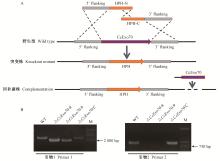
Fig.2
Targeted gene deletion and complementation A: Construction strategy of mutants and complementary strain; B: Specific primers were used to verify the transformed strains by PCR.Primer 1:External primer for target gene External- Exo70for/External-Exo70rev, M: 1 000 marker; Primer 2:Target gene internal primer Internal-Exo70for/Internal-Exo70rev, M: 250 marker."

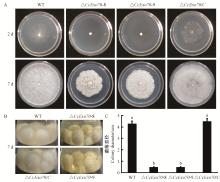
Fig.3
Radial growth in CcExo70 deletion mutant A: Colony morphologies of the wild-type, mutant, and complemented strains after 2 and 7 days of growth on PDA plates; B: The mycelia morphology of the strains after 7 d of growth in liquid PDB; C.Statistical analysis of colony diameters of the indicated strains after 2 d on media.Error bars are standard deviation and different lowercases represent significant difference at P < 0.05."


Fig.4
Mycelium morphology of CcExo70 deletion mutant A: The strain was cultured at 25℃ on a slide containing PDA ramp for 3 days, then the mycelia morphology was observed under microscope; B: The number of single mycelium branches was counted under microscope.Error bars are standard deviation and different lowercases represent significant difference at P < 0.05."
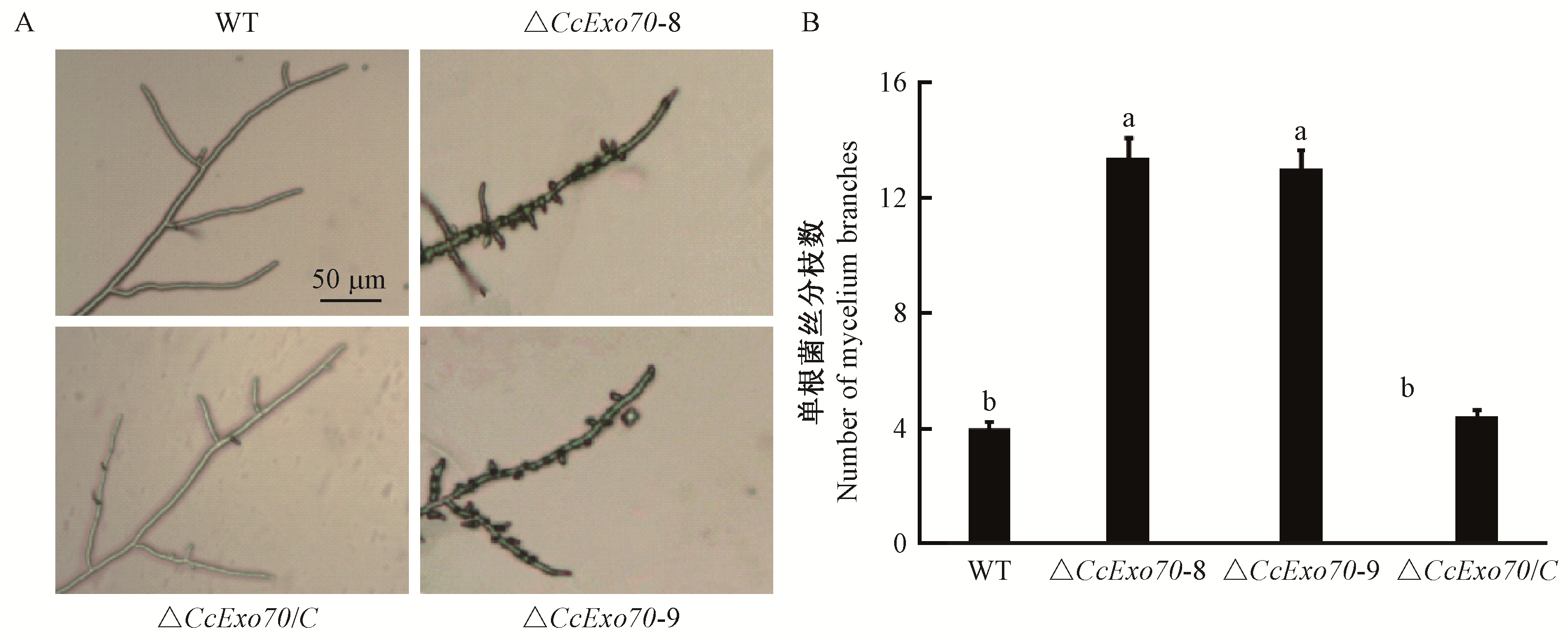

Fig.5
Measurement of oxidative stress in CcExo70 deletion mutants A: Growth status of wild-type, mutant and complementary strains grown on PDA plates with or without drip addition (CK) of 2 mol·L-1 and 3.5 mol·L-1 H2O2.All strains were incubated at 25℃ for 3 d and photographed.B: The inhibition diameters of different strains were quantitatively analyzed.Error bars are standard deviation and different lowercases represent significant difference at P < 0.05."
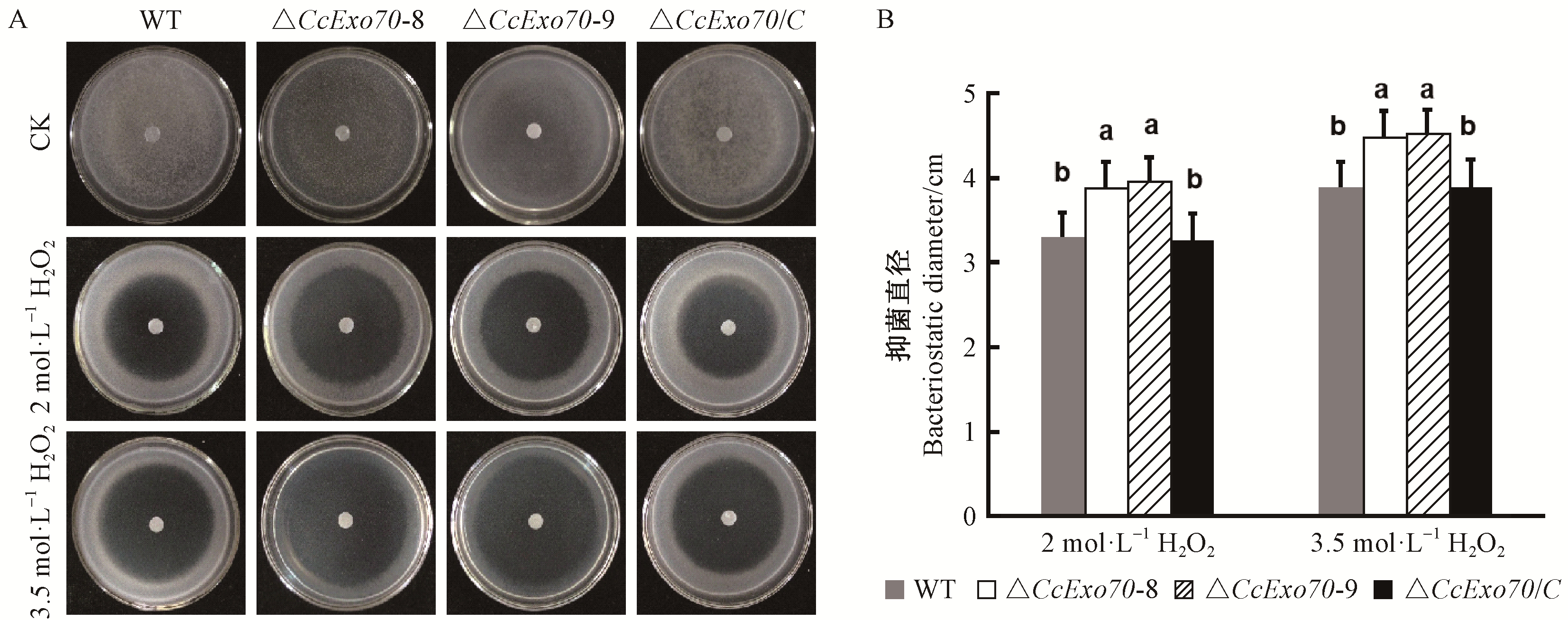
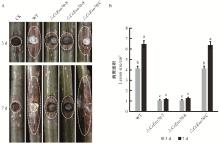
Fig.6
Pathogenicity determination of CcExo70 deletion mutant A: Infection symptoms on detached poplar twigs inoculated with the wild-type, mutant, and complemented strains after 3 d and 7 d.The area of lesions is outlined with a dotted line.B: Area of lesions produced by the different strains on twigs.Error bars are standard deviation and different lowercases represent significant difference at P < 0.05."

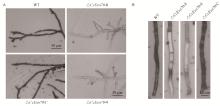
Fig.7
Detection of superoxide production A: Detection of superoxide production by DAB staining.Dark DAB dye in wild type strain suggested a high ROS level, while the mutant showed less color, indicating a reduced ROS accumulation.The reconstituted strain exhibited a darker color similar to wild type.B: Accumulation of ROS in single hyphae after two days of DAB staining.All strains were cultured on PDA plate at 25℃ for 2 days, then observed under light microscope after DAB staining."


Fig.8
Distribution of chitin in the CcExo70 deletion mutant A: Mycelium of WT, ΔCcExo70 and the ΔCcExo70/C strains were stained by calcofluor white (CFW) to observe chitin accumulation.B: Chitin deposition at the tip of mycelia.Compared with the wild type and complementary strains, there was no obvious chitin deposition at the tip of the mutant hyphae.C: After CFW staining, the septal distribution of wild type and complementary strains was significantly less than that of mutant strains under fluorescence microscope.D: The number of septa in mycelium cytoplasm of wild type, ΔCcExo70 and complementary strains.Error bars are standard deviation and different lowercases represent significant difference at P < 0.05."

Table 2
List of proteins with abundances fall by over half in ΔCcExo70-F compared to WT-F"
| 基因名称 Gene name | 蛋白长度 Protein length/bp | 半胱氨酸的数量 Number of cysteine | 突变体/野生型 ΔCcExo70-F/WT-F | 结构域预测 Interproprediction |
| CcSP1 | 514 | 4 | 0.29 | 热激蛋白HSP70家族(IPR013126) Heat shock protein 70 family(IPR013126) |
| CcSP2 | 278 | 7 | 0.48 | 肽酶G1(IPR000250) Peptidase G1(IPR000250) |
| CcSP3 | 401 | 0 | 0.39 | 乳糖酶,7叶片β-螺旋(IPR019405) Lactonase, 7-bladed β-helix(IPR019405) |
| CcSP4 | 501 | 6 | 0.26 | 蛋白二硫化物异构酶(IPR005792) Protein disulphide isomerase(IPR005792) |
| CcSP5 | 379 | 2 | 0.34 | L-赖氨酸6-单氧酶/L-鸟氨酸5-单氧酶(IPR025700) L-lysine 6-monooxygenase/L-ornithine 5-monooxygenase(IPR025700) |
| CcSP6 | 956 | 10 | 0.07 | 糖苷水解酶家族31(IPR000322) Glycoside hydrolase family 31(IPR000322) |
| CcSP7 | 505 | 8 | 0.39 | α-L-阿拉伯呋喃糖苷酶B(IPR038964) α-L-arabinofuranosidase B(IPR038964) |
| CcSP8 | 1 021 | 3 | 0.20 | 热激蛋白HSP70家族(IPR013126) Heat shock protein 70 family(IPR013126) |
| 陈洪珠. 杨树腐烂病防治措施. 农村科技, 2013, 30 (4): 37. | |
| Chen H Z . Control measures of poplar canker. Rural Science and Technology, 2013, 30 (4): 37. | |
| 胡彬彬, 林连兵, 魏云林, 等. 一种高效的真菌总蛋白质提取方法. 中国生物工程杂志, 2013, 33 (9): 53- 58. | |
| Hu B B , Lin L B , Wei Y L , et al. An efficient method for extracting total protein from fungi. Journal of Chinese Biotechnology, 2013, 33 (9): 53- 58. | |
| 贾美慧, 屠宝玉, 韩宝达, 等. 细胞内膜泡运输中栓系因子功能. 植物生理学报, 2012, 48 (1): 29- 43. | |
| Jia M H , Tu B Y , Han B D , et al. Function of tethering factors in vesicle transport. Plant Physiology Journal, 2012, 48 (1): 29- 43. | |
|
李东. 杨树腐烂病发病规律与综合防治措施. 防护林科技, 2010, 28 (5): 69- 71.
doi: 10.3969/j.issn.1005-5215.2010.05.023 |
|
|
Li D . Occurrence regularity and integrated control measures of poplar canker. Shelterbelt Technology, 2010, 28 (5): 69- 71.
doi: 10.3969/j.issn.1005-5215.2010.05.023 |
|
| 刘玲玲, 王永林, 熊典广, 等. 杨树腐烂病菌(Cytospora chrysosperma)原生质体遗传转化体系的构建. 微生物学通报, 2017, 44 (10): 2487- 2497. | |
| Liu L L , Wang Y L , Xiong D G , et al. Construction of protoplast transformation system of Cytospora chrysosperma. Microbiology China, 2017, 44 (10): 2487- 2497. | |
| 王爽, 姜兰香, 张宇, 等. 真菌胞内蛋白质提取方法的建立. 吉林大学学报: 医学版, 2012, 38 (3): 206- 210. | |
| Wang S , Jiang L X , Zhang Y , et al. Establishment of a method to extract protein from fungi. Journal of Jilin University: Medical Edition, 2012, 38 (3): 206- 210. | |
|
闫腾飞. 杨树腐烂病的防治研究. 农业科技与信息, 2016, 33 (22): 115- 116.
doi: 10.3969/j.issn.1003-6997.2016.22.083 |
|
|
Yan T F . Prevention and treatment of poplar canker. Agricultural Science and Information, 2016, 33 (22): 115- 116.
doi: 10.3969/j.issn.1003-6997.2016.22.083 |
|
|
张星耀, 陈海燕, 梁军, 等. 金黄壳囊孢菌(Cytospora chrysosperma)的培养性状和营养体亲和性. 西北农林科技大学学报: 自然科学版, 2007, 35 (3): 99- 105.
doi: 10.3321/j.issn:1671-9387.2007.03.021 |
|
|
Zhang X Y , Chen H Y , Liang J , et al. Cultural morphology and vegetative compatibility of Cytospora chrysosperma isolates. Northwest A & F University: Natural Science Edition, 2007, 35 (3): 99- 105.
doi: 10.3321/j.issn:1671-9387.2007.03.021 |
|
|
Adams G C , Roux J , Wingfield M J . Cytospora species(Ascomycota, Diaporthales, Valsaceae): introduced and native pathogens of trees in South Africa. Australasian Plant Pathology, 2006, 35 (5): 521- 548.
doi: 10.1071/AP06058 |
|
|
Bendezú F O , Vincent V , Martin S G , et al. Fission yeast Sec3 and Exo70 are transported on actin cables and localize the exocyst complex to cell poles. PloS ONE, 2012, 7 (6): e40248.
doi: 10.1371/journal.pone.0040248 |
|
|
Biggs A R , Davis D D , Merrill W . Histopathology of cankers on Populus caused by Cytospora chrysosperma. Canadian Journal of Botany, 1983, 61 (2): 563- 574.
doi: 10.1139/b83-064 |
|
|
Bradford M M . A rapid and sensitive method for the quantitation of microgram quantities of protein utilizing the principle of protein-dye binding. Analytical Biochemistry, 1976, 72, 248- 254.
doi: 10.1016/0003-2697(76)90527-3 |
|
|
Chen X , Ebbole D J , Wang Z . The exocyst complex: delivery hub for morphogenesis and pathogenesis in filamentous fungi. Current Opinion in Plant Biology, 2015, 28, 48- 54.
doi: 10.1016/j.pbi.2015.09.003 |
|
|
Chen X W , Leto D , Xiao J , et al. Exocyst function is regulated by effector phosphorylation. Nature Cell Biology, 2011, 13 (5): 580- 588.
doi: 10.1038/ncb2226 |
|
|
Egan M J , Wang Z Y , Jones M A , et al. Generation of reactive oxygen species by fungal NADPH oxidases is required for rice blast disease. Proceedings of the National Academy of Sciences of the United States of America, 2007, 104 (28): 11772- 11777.
doi: 10.1073/pnas.0700574104 |
|
| Fan X L , Liang Y M , Ma R , et al. Morphological and phylogenetic studies of Cytospora(Valsaceae, Diaporthales) isolates from Chinese scholar tree, with description of a new species. Mycoscience, 2013, 55 (4): 252- 259. | |
| Fischer-Parton S , Parton R M , Hickey P C , et al. Confocal microscopy of FM4-64 as a tool for analysing endocytosis and vesicle trafficking in living fungal hyphae. Journal of Microscopy, 2010, 198 (Pt 3): 246- 259. | |
| Giraldo M C , Dagdas Y F , Gupta Y K , et al. Two distinct secretion systems facilitate tissue invasion by the rice blast fungus Magnaporthe oryzae. Nature Communications, 2013, 4 (3): 1996. | |
| Goswami R S . Targeted gene replacement in fungi using a split-marker approach. Methods in Molecular Biology, 2012, 835, 255- 269. | |
|
Guan W , Feng J , Wang R , et al. Functional analysis of the exocyst subunit BcExo70 in Botrytis cinerea. Current Genetics, 2020, 66 (1): 85- 95.
doi: 10.1007/s00294-019-01002-9 |
|
| Gupta Y K , Dagdas Y F , Martinez-Rocha A L , et al. Septin-dependent assembly of the exocyst is essential for plant infection by Magnaporthe oryzae. The Plant Cell, 2015, 27 (11): 3277- 3289. | |
| Guyon J C , Jacobi W R , Mcintyre G A . Effects of environmental stress on the development of Cytospora canker of aspen. Plant Disease, 1996, 80 (12): 1320- 1326. | |
| Harris S D , Morrell J L , Hamer J E . Identification and characterization of Aspergillus nidulans mutants defective in cytokinesis. Genetics, 1994, 136 (2): 517- 532. | |
| Heider M R , Munson M . Exorcising the exocyst complex. Traffic, 2012, 13 (7): 898- 907. | |
| Hückelhoven R . Transport and secretion in plant-microbe interactions. Current Opinion in Plant Biology, 2007, 10 (6): 573- 579. | |
| Jeanmougin F , Thompson J D , Gouy M , et al. Multiple sequence alignment with Clustal X. Trends in Biochemical Sciences, 1998, 23 (10): 403- 405. | |
| Kamoun S . A catalogue of the effector secretome of plant pathogenic Oomycetes. Annual Review of Phytopathology, 2006, 44 (1): 41- 60. | |
| Kinch L N , Grishin N V . Longin-like folds identified in CHiPS and DUF254 proteins: vesicle trafficking complexes conserved in eukaryotic evolution. Protein Science, 2006, 15 (11): 2669- 2674. | |
| Li C R , Lee T H , Wang Y M , et al. Candida albicans hyphal morphogenesis occurs in Sec3p-independent and Sec3p-dependent phases separated by septin ring formation. Journal of Cell Science, 2007, 120 (11): 1898. | |
| Lipschutz J H , Mostov K E . Exocytosis: the many masters of the exocyst. Current Biology, 2002, 12 (6): R212- 214. | |
| Liu J , Wei G . The exocyst complex in exocytosis and cell migration. Protoplasma, 2012, 249 (3): 587- 597. | |
| Pallant J . SPSS survival manual: a step by step guide to data analysis using SPSS for windows. Australian & New Zealand Journal of Public Health, 2013, 37 (6): 597- 598. | |
| Riquelme M , Sánchez-León E . The Spitzenkörper: a choreographer of fungal growth and morphogenesis. Current Opinion in Microbiology, 2014, 20, 27- 33. | |
| Rivera-Molina F , Toomre D . Live-cell imaging of exocyst links its spatiotemporal dynamics to various stages of vesicle fusion. Journal of Cell Biology, 2013, 201 (5): 673- 680. | |
| Shen D , Yuan H , Hutagalung A , et al. The synaptobrevin homologue Snc2p recruits the exocyst to secretory vesicles by binding to Sec6p. Journal of Cell Biology, 2013, 202 (3): 509- 526. | |
| Song W , Dou X , Qi Z , et al. R-SNARE homolog MoSec22 is required for conidiogenesis, cell wall integrity, and pathogenesis of Magnaporthe oryzae. PLoS ONE, 2010, 5 (10): e13193. | |
| Stenmark H . Rab GTPases as coordinators of vesicle traffic. Molecular Cell Biology, 2009, 10 (8): 513- 525. | |
| Su Y , Hui-Guang L , Yonglin W , et al. Poplar miR472a targeting NBS-LRRs is involved in effective defense response to necrotrophic fungus Cytospora chrysosperma. Journal of Experimental Botany, 2018, 69 (22): 5519- 5530. | |
| Tamura K , Stecher G , Peterson D , et al. MEGA6:Molecular Evolutionary Genetics Analysis version 6. 0. Molecular Biology and Evolution, 2013, 30 (12): 2725- 2729. | |
| Unwin R D , Griffiths J R , Whetton A D . Simultaneous analysis of relative protein expression levels across multiple samples using iTRAQ isobaric tags with 2D nano LC-MS/MS. Nature Protocols, 2010, 5 (9): 1574- 1582. | |
| Wang Y L , Lu Q , Decock C , et al. Cytospora species from Populus and Salix in China with C. davidiana sp. nov. Fungal Biology, 2015, 119 (5): 420- 432. | |
| Wang Y Y , WangY L . Oxalic acid metabolism contributes to full virulence and pycnidial development in the poplar canker fungus Cytospora chrysosperma. Phytopathology, 2020, 110 (7): 1319- 1325. | |
| Wiese S , Reidegeld K A , Meyer H E , et al. Protein labeling by iTRAQ: a new tool for quantitative mass spectrometry in proteome research. Proteomics, 2007, 7 (3): 340- 350. | |
| Yu C L , Ting L , Liu X S , et al. Deletion of endo-β-1, 4-xylanase VmXyl1 impacts the virulence of Valsa mali in apple tree. Frontiers in Plant Science, 2018, 9, 663. | |
| Yu L , Xiong D G , Han Z , et al. The mitogen-activated protein kinase gene CcPmk1 is required for fungal growth, cell wall integrity and pathogenicity in Cytospora chrysosperma. Fungal Genetics and Biology, 2019, 128, 1- 13. |
| [1] | Xiya Li,Shengpei Zhang,He Li. Function of Vacuolar Protein Sorting CfVps26 in Colletotrichum fructicola on Camellia oleifera [J]. Scientia Silvae Sinicae, 2021, 57(8): 94-101. |
| [2] | Yalan Gao,Yuanhao He,He Li. Biological Function bZIP-Type Transcription Factor CfAp1 in Colletotrichum fructicola [J]. Scientia Silvae Sinicae, 2020, 56(9): 30-39. |
| [3] | Lihua Zhu,Xinyue Zhang,Xinrui Xia,Yu Wan,Shanjun Dai,Jianren Ye. Pathogenicity of Aseptic Bursaphelenchus xylophilus on Pinus massoniana [J]. Scientia Silvae Sinicae, 2020, 56(7): 63-69. |
| [4] | Yefan Cao,Laifa Wang,Xizhuo Wang,Jiehong Fan. Pathogenicity of Bursaphelenchus xylophilus to Larix olgensis Seedlings [J]. Scientia Silvae Sinicae, 2020, 56(11): 108-115. |
| [5] | Ye Bihuan, Zhang Yabo, Shu Jinping, Wu Hong, Wang Haojie. Effects of Three Different Metarhizium Strains on Virulence and Protective Enzymes Activities of Melanotus cribricollis larvae [J]. Scientia Silvae Sinicae, 2018, 54(6): 100-108. |
| [6] | Lin Li, Zhou Lei, Pan Jun, Kang Lipeng, Ye Jianren, Zhu Lihua. Pathogenicity of Aseptic and Germ-Carrying Bursaphelenchus xylophilus on Pinus densiflora [J]. Scientia Silvae Sinicae, 2017, 53(5): 82-87. |
| [7] | Wei Qiang, Li Aining, He Wei. Functional Analysis of LqHK1 in Lonsdalea quercina subsp. populi [J]. Scientia Silvae Sinicae, 2017, 53(4): 105-112. |
| [8] | Cao Qingjie, Chi Defu. Screening of High Virulent Entomopathogenic Fungal Strains to Infect Larvae of Cryptorrhynchus lapathi (Coleoptera: Curculionidae) [J]. Scientia Silvae Sinicae, 2017, 53(1): 119-127. |
| [9] | Su Xiaoyu, Wang Jing, Ren Xiaojing, Li Huiping. Ultraviolet Mutation Breeding for High Toxicity Strains of Beauveria bassiana against Larvae of Hyphantria cunea (Drury) [J]. Scientia Silvae Sinicae, 2016, 52(7): 165-169. |
| [10] | Li Bin, Li Aining, Wei Qiang, Wang Haiming, He Wei. Functional Analysis of hrcJ Gene in Lonsdalea quercina subsp. populi [J]. Scientia Silvae Sinicae, 2015, 51(12): 71-78. |
| [11] | Yang Mingxiu, Song Ruiqing. Pathogenic Differentiation and Genetic Diversity of Cytospora chrysosperma in China [J]. Scientia Silvae Sinicae, 2013, 49(6): 115-121. |
| [12] | Zhang Ming;Song Xiaobin;Zhang Xingyao;Wang Zhenchao;Liang Jun. Effects of Pulsed Magnetic Field on Growth and Infestation of Botryosphaeria dothidea [J]. Scientia Silvae Sinicae, 2011, 47(11): 80-87. |
| [13] | Huang Lin;Xu Xuling;Li Chao;Ye Jianren;Wu Xiaoqin. cDNA Library Construction and Analysis of Differentially Expressed in Mixed Stage Nematode of Bursaphelenchus xylophilus [J]. Scientia Silvae Sinicae, 2011, 47(10): 98-103. |
| [14] | Ben Ailing;Guo Ye;Han Zhengmin. Hybridization between Bursaphelenchus xylophilus and B. mucronatus and the Pathogenicity of the Offspring [J]. Scientia Silvae Sinicae, 2010, 46(8): 114-119. |
| [15] | Chen Fengmao;Shi Yanmei;Wang Shuying;Tang Jian;Sun Cuiyun;Ye Jianren;. Pathogenicity of Different Isolates of Bursaphelenchus mucronatus to Pinus taiwanensis and P. thunbergii Seedlings [J]. Scientia Silvae Sinicae, 2010, 46(12): 86-90. |
| Viewed | ||||||
|
Full text |
|
|||||
|
Abstract |
|
|||||